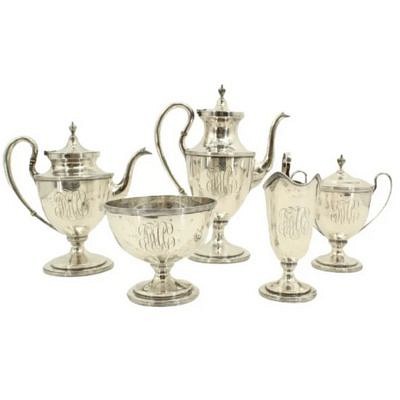German Version of the Lusitania Medal 1915
About Seller
522 South Pineapple Avenue
Sarasota, FL 34236
United States
Sarasota Estate Auction specializes in a wide variety of furniture, antiques, fine art, lighting, sculptures, and collectibles. Andrew Ford, owner and operator of the company, has a passion for finding the best pieces of art and antiques and sharing those finds with the Gulf Coast of Florida.
Two ways to bid:
- Leave a max absentee bid and the platform will bid on your behalf up to your maximum bid during the live auction.
- Bid live during the auction and your bids will be submitted real-time to the auctioneer.
Bid Increments
| Price | Bid Increment |
|---|---|
| $0 | $10 |
| $100 | $25 |
| $250 | $50 |
| $1,000 | $100 |
| $2,500 | $250 |
| $7,500 | $500 |
| $20,000 | $1,000 |
| $50,000 | $2,500 |
| $100,000 | $5,000 |
| $250,000 | $10,000 |
About Auction
Jan 20, 2024
Artists to include: Jorge Blanco, Leonardo Nierman, Picasso, LeRoy Neiman, Darrell Crisp, Francois Krige, Mino Delle Site, Peter Max, Edward Povey, Sky Jones, Robert Rauschenberg, and others. There are also 7 Original Charles Schulz Drawings done by Reuben Timmins, Production Cels, over 200 lots of Important Books and Manuscripts, Sterling Silver, a Jane Kostick Geometric Wooden Sculpture, Modern Design and Furniture, Fantastic Estate Jewelry, and so much more! Sarasota Estate Auction sarasotaestateauction@gmail.com
- Lot Description
German Version of the Lusitania Medal 1915. The Lusitania medal was a propaganda piece for the German and British sides in World War I, and this is the German version of the Lusitania medal, along with a booklet from the Rosemary Press titled “Germany and the Lusitania Medal”. The Lusitania was an British-registered ocean liner run by the Cunard Line and sunk by a German submarine during World War I, nearly 1200 people lost their lives when the ship went down, including many women and children, and 123 Americans, and this tragedy turned public opinion against Germany. President Wilson wanted to stay out of the war, to save American lives, but American outrage grew, and two years later, America entered the war, despite Wilson’s position of of neutrality, and the sinking of the Lusitania contributed to this change of heart. The words are in German on both medals, but the dates are different for each one. The date on the German version was “5 MAI 1915” and the date on the British version was altered to “5 MAY 1915”, and this medal has “Mai”, and not “May”, so it is the German version. The design of the original medal was created by Karl Goetz, whose initials “K.G.” are on the bottom of the reverse, and it was made of iron. The actual date of the sinking was May 7, 1915, and when Goetz realized his mistake, he created a second design in bronze with the corrected date of “7 MAI 1915”. (See a copy of the second version in bronze at the Merseyside Maritime Museum at the Royal Albert Dock in Liverpool.) Goetz cast less than 500 original medals in the privacy of his own home, and they were propaganda statements for him which satirized the British position in the incident. The German embassy had been warning people not to sail at this time because it was wartime and U-boats were on the hunt for enemy ships, and even though a British ship had been sunk, Goetz was blaming the British government and the Cunard Line for what happened. The reverse of the medal shows a line of people at the Cunard ticket office, with a skeleton representing death handing out tickets. At the top of the medal are the German words for “Business Above All” mocking the Cunard Line for willingly placing passengers’ lives at stake - the words are “Geschäft Über Alles” - and on the left a man is reading a newspaper with the German words for “U-Boat danger”. British Intelligence got wind of the medal and tried to get back at the Germans by creating over 200,000 replica copies, with the hope that people would realize a German U-boat actually killed the people on the Lusitania, but the British changed the date on their version to read “5 May 1915”, and their copies came in a presentation box with an explanatory certificate - the box and certificate are both lacking here because it isn’t the British version - and the British copies were a cruder or rougher cast than the original German versions. This copy measures 55 mm. in diameter and we know it is made out of iron and not bronze because we used a magnet to see if would stick to the surface of the medal, and it did, so it is definitely made out of iron and not bronze, and there are small brown specks here and there on the surface of the medal, but you have to look to find them. The booklet is titled “Rosemary Press Brochures, Germany and The Lusitania Medal”, it is in blue wrappers with gilt letters on the cover and a yellow string binding, as called for, the frontispiece is a plate showing the front and back of the medal, then the title page, a copyright page dated 1923, a page dedicated to the American Legion, a copy of a notice to travelers sailing across the Atlantic that they travel at their own risk - the notice came from the German Embassy in Washington - and seven pages of text, including two more plates showing other medals by Goetz related to the war. The booklet measures 9 3/8 x 6 3/8 in. wide and is in very good condition, with a tight binding, clean pages and clean plates, with just a tad of shadows in the margins on a couple of pages, and there are slight corner creases on the covers and light fading on the edges of the spine, and it comes in a in a maroon case to protect the brochure. A rare medal from World War I which commemorated a tragic event and was exploited by both sides in the early stages of the war. #208 #1574
- Shipping Info
-
SHIPPING INFORMATION·
Sarasota Estate Auction IS NOT RESPONSIBLE FOR SHIPPING. All shipping will be handled by the winning bidder. Sarasota Estate Auction recommends obtaining shipping quotes before bidding on any items in our auctions. If you are interested in obtaining any information on local shippers, please send us an email and we will kindly send you a list of local shippers. Refunds are not offered under any circumstances base on shipping issues, this is up to the buyer to arrange this beforehand.
Premier Shipping, info@premiershipment.com
BIDDER MUST ARRANGE THEIR OWN SHIPPING. Although SEA will NOT arrange shipping for you, we do recommend our shipper Premier Shipping & Crating at info@premiershipment.com You MUST email them, please do not call. If you'd like to compare shipping quotes or need more options, feel free to contact any local Sarasota shippers. You can email any one of the shippers below as well. Be sure to include the lot(s) you won and address you would like it shipped to. Brennan with The UPS Store #0089 - 941-413-5998 - Store0089@theupsstore.com AK with The UPS Store #2689 - 941-954-4575 - Store2689@theupsstore.com Steve with The UPS Store #4074 - 941-358-7022 - Store4074@theupsstore.com Everett with PakMail - 941-751-2070 - paktara266@gmail.com
-
- Payment & Auction Policies
-
Available payment options
We accept all major credit cards, wire transfers, money orders, checks and PayPal. Please give us a call at (941) 359-8700 or email us at SarasotaEstateAuction@gmail.com to take care of your payments.
-
- Buyer's Premium



 EUR
EUR CAD
CAD AUD
AUD GBP
GBP MXN
MXN HKD
HKD CNY
CNY MYR
MYR SEK
SEK SGD
SGD CHF
CHF THB
THB


























![Three Titles of Annales du Musee du Congo [Belge] Publications in Five Volumes](https://s1.img.bidsquare.com/item/m/3196/31969686.jpeg?t=1UEGcz)



